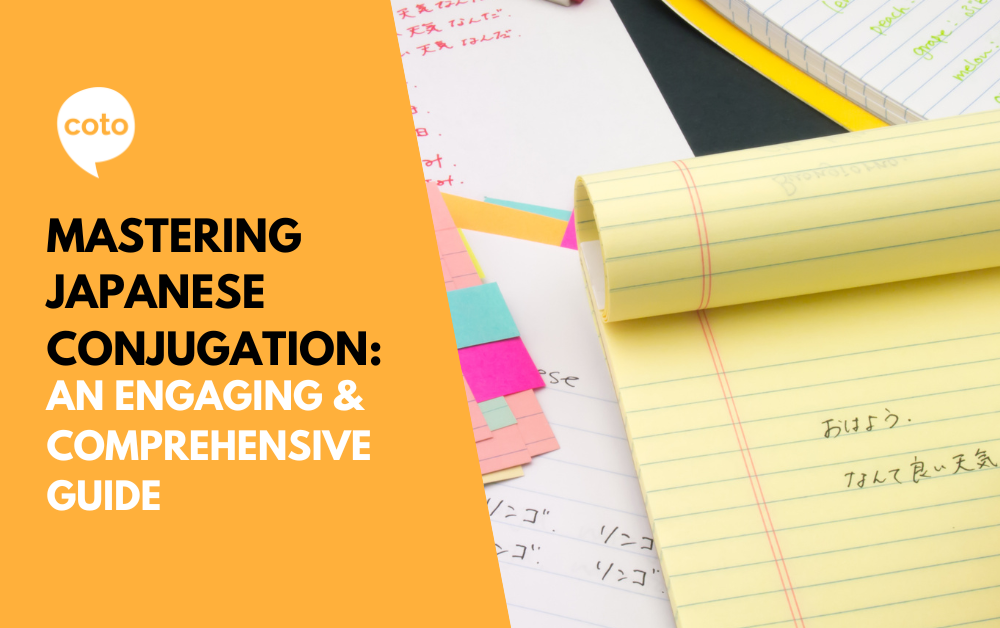Learning Japanese conjugation doesn’t have to be a dry and daunting task. In fact, it can be an exciting journey filled with twists and turns, much like a thrilling adventure. So, fasten your seatbelts as we embark on a quest to unravel the mysteries of Japanese conjugation, sprinkling a dash of fun and excitement into this linguistic adventure.
Jump to
Politeness Levels and the Language Duel
- Polite Form (ます – masu)
- Plain Form (だ – da or です – desu)
- Humble Form (おります・いたします – orimasu/itashimasu)
Time Traveling with Tenses and Aspects

Our adventure begins deep within the Verb Jungle, where three distinct groups of verbs await. Think of this as selecting your character class in a video game, with each group presenting its unique set of challenges and rules.
Group 1 (u-verbs)
These verbs end in -u and can be likened to the rogues of the jungle. Transforming them is as simple as swapping -u with -i for the present affirmative form or -imasen for the present negative form. For the past tense, it’s a matter of replacing -u with -ta. However, for the past tense, don’t forget to change the -u to -i first!
飲む・のむ・nomu – to drink
| | Affirmative Polite Form | Negative Polite Form |
|---|---|---|
| Present | 飲みます・のみます・nomimasu | 飲みません・のみません・ nomimasen |
| Past | 飲みました・のみました・nomimashita | 飲みませんでした・のみませんでした・ nomimasen deshita |
So, when you wish to say, “I drink,” it becomes “のみます・nomimasu” If you’d like to express, “I don’t drink,” it’s as easy as saying “のみません・nomimasen.” To recount that delightful drink you savored yesterday, simply utter “のみました・nomimashita.” For more examples, you can check this blog post to ease your learning!
Group 2 (ru-verbs)
These verbs, often ending in -ru, can be seen as the knights of the Verb Jungle. Conjugating them involves wielding your conjugation sword and removing the -ru, then adding -masu for the present affirmative form, -masen for the present negative form, and -mashita for the past tense.
乗る・のる・noru – to ride
| Affirmative Polite Form | Negative Polite Form | |
|---|---|---|
| Present | 乗ります・のります・norimasu | 乗りません・のりません・norimasen |
| Past | 乗りました・のりました・norimashita | 乗りませんでした・乗りませんでした・norimasendeshita |
Irregular Verbs
Enter the world of irregular verbs, the mystical wizards of the Verb Jungle. These verbs, like “suru” (to do) and “kuru” (to come), defy the usual rules and have their own unique conjugation patterns that require memorization.
する・suru – to do
| | Affirmative Polite Form | Negative Polite Form |
|---|---|---|
| Present | します・shimasu | しません・shimasen |
| Past | しました・shimashita | しませんでした・shimasen deshita |
来る・くる・kuru – to come
| | Affirmative Polite Form | Negative Polite Form |
|---|---|---|
| Present | 来ます・きます・kimasu | 来ません・きません・norimasen |
| Past | 来ました・きました・kimashita | 来ませんでした・きませんでした・kimasendeshita |
Grooving with Adjectives

With the Verb Jungle behind us, let’s groove on the Dancefloor of Descriptions with Japanese adjectives, which come in two distinct styles: i-adjectives and na-adjectives.
i-Adjectives
Picture these adjectives as the life of the party, ending with -i. To get into the adjective groove, simply replace -i with -katta for the past tense or -ku nai for the negative form.
高い・たかい・takai – tall/expensive/high
| | Affirmative Polite Form | Negative Polite Form |
|---|---|---|
| Present | 高いです・たかいです・ takai desu | 高くありません・たかくありません・takaku arimasen |
| Past | 高かったです・たかかったです・takakatta desu | 高くありませんでした・たかくありませんでした・takaku arimasen deshita |
When you want to say, “It’s high,” it becomes “Takai.” But when you recall that it wasn’t so tall, it transforms into “Takakunai.” And if you spent time with a tall friend last night, you reminisce with “Takakatta.”
na-Adjectives
These adjectives prefer to keep things chill and add “na” when they hang out with nouns. Conjugating them is a breeze—just add -datta for the past tense and -ja nai for the negative form.
静かな・しずかな・shizukana – quiet, peaceful
| | Affirmative Polite Form | Negative Polite Form |
|---|---|---|
| Present | 静かなです・しずかなです・ shizukana desu | 静かじゃないです・しずかじゃないです・shizuka jyanai desu |
| Past | 静かだったです・しずかだったです・shizukadatta desu | 静かじゃなかったです・しずかじゃなかったです・shizuka jyanakatta desu |
So, “It’s quiet” becomes “Shizuka na.” To say it’s not quiet, it’s “Shizuka ja nai,” and when reminiscing about a noisy night, it’s “Shizuka datta.”
Politeness Levels and the Language Duel

In the Land of Politeness, conjugation becomes a refined art form, much like a duel between samurai. Here, there are three levels of politeness, and choosing the right one can be as crucial as striking with precision.
Polite Form (ます – masu)
Imagine this as donning your finest kimono for a royal banquet. It’s used in formal situations, such as speaking with superiors, strangers, or during business transactions. The conjugation follows the standard rules we’ve learned.
食べる・たべる・taberu – to eat
| Affirmative Present | 食べます・たべます・tabemasu |
| Affirmative Past | 食べました・たべました・tabemashita |
| Negative Present | 食べません・たべません・tabemasen |
| Negative Past | 食べませんでした・たべませんでした・tabemasendeshita |
Plain Form (だ – da or です – desu)
Picture this as wearing jeans and a T-shirt to meet friends at the local ramen shop. It’s for casual, everyday interactions. For verbs, it uses the dictionary form (the basic form before conjugation). For adjectives, it’s the same as the affirmative form.
食べる・たべる・taberu – to eat
| Affirmative Present | 食べる・たべる・taberu |
| Affirmative Past | 食べた・たべた・tabeta |
| Negative Present | 食べない・たべない・tabenai |
| Negative Past | 食べなかった・たべなかった・tabenakatta |
Humble Form (おります・いたします – orimasu/itashimasu)
Imagine donning an elaborate kimono to serve tea to your honored guests. It’s used when showing respect or humility, often in business or customer service. The conjugation has its unique patterns.
For example, instead of saying “I will eat,” you say “飯をいただきます・Meshi o itadakimasu.”
To be sure and check your skill, you can check these two sites to see different Japanese conjugations.
Time Traveling with Tenses and Aspects

In our linguistic adventure, we’ve discovered that conjugation can also transport us through time, much like a time-traveling explorer. Japanese offers various tenses and aspects to explore.
Present Continuous
To express ongoing actions in the present, add -te iru to the verb stem.
So, “I am eating” becomes “Tabete iru.”
Past Continuous
To express ongoing actions in the past, add -te ita to the verb stem.
“I was eating” becomes “Tabete ita.”
Present Perfect
To express an action completed in the past but still relevant in the present, add -te aru or -te iru to the verb stem.
So, “I have eaten” becomes “Tabete aru.”
Conclusion

Our adventure through the captivating world of Japanese conjugation has come to a close. We’ve navigated the Verb Jungle, grooved on the Dancefloor of Adjective, dueled in the Land of Politeness, and embarked on time-traveling escapades through tenses and aspects.
Now that you’ve (hopefully) learned how to conjugate different words in Japanese, test your knowledge here!
Remember, learning Japanese conjugation can be a thrilling journey, and it’s a key to unlocking deeper cultural understanding and effective communication. Keep practicing, and explore additional resources, and soon you’ll be mastering this intricate aspect of the Japanese language with confidence.
If you also want to put your knowledge to the test and use it, you can also join the next adventure in our classes here! Can’t wait to see you on our journey too!
Now, like a seasoned adventurer, venture forth and conquer the world of Japanese conjugation!
